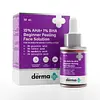What's inside
What's inside
 Key Ingredients
Key Ingredients

 Benefits
Benefits

 Concerns
Concerns

 Ingredients Side-by-side
Ingredients Side-by-side

Water
Skin ConditioningAloe Barbadensis Leaf Juice
Skin ConditioningGlycolic Acid
BufferingLactic Acid
BufferingMandelic Acid
AntimicrobialPropylene Glycol
HumectantCucurbita Pepo Seed Extract
Skin ConditioningSodium Hydroxide
BufferingSalicylic Acid
MaskingChamomilla Recutita Extract
Skin ConditioningPanthenol
Skin ConditioningCalendula Officinalis Flower Extract
MaskingSodium Hyaluronate
HumectantCamellia Sinensis Leaf Extract
AntimicrobialPhenoxyethanol
PreservativeChlorphenesin
AntimicrobialGlycerin
HumectantSodium Benzoate
MaskingDisodium EDTA
Water, Aloe Barbadensis Leaf Juice, Glycolic Acid, Lactic Acid, Mandelic Acid, Propylene Glycol, Cucurbita Pepo Seed Extract, Sodium Hydroxide, Salicylic Acid, Chamomilla Recutita Extract, Panthenol, Calendula Officinalis Flower Extract, Sodium Hyaluronate, Camellia Sinensis Leaf Extract, Phenoxyethanol, Chlorphenesin, Glycerin, Sodium Benzoate, Disodium EDTA
Water
Skin ConditioningDimethyl Isosorbide
SolventEthoxydiglycol
HumectantAlpha-Arbutin
AntioxidantLactic Acid
BufferingPentylene Glycol
Skin ConditioningFerulic Acid
AntimicrobialSodium Hyaluronate
Humectant4-Butylresorcinol
AntioxidantHydroxyethylcellulose
Emulsion StabilisingTriethanolamine
BufferingPEG/PPG-17/6 Copolymer
SolventIsoceteth-20
EmulsifyingXanthan Gum
EmulsifyingLecithin
EmollientSclerotium Gum
Emulsion StabilisingPullulan
Phenoxyethanol
PreservativeEthylhexylglycerin
Skin ConditioningTrisodium Ethylenediamine Disuccinate
Water, Dimethyl Isosorbide, Ethoxydiglycol, Alpha-Arbutin, Lactic Acid, Pentylene Glycol, Ferulic Acid, Sodium Hyaluronate, 4-Butylresorcinol, Hydroxyethylcellulose, Triethanolamine, PEG/PPG-17/6 Copolymer, Isoceteth-20, Xanthan Gum, Lecithin, Sclerotium Gum, Pullulan, Phenoxyethanol, Ethylhexylglycerin, Trisodium Ethylenediamine Disuccinate
Ingredients Explained
These ingredients are found in both products.
Ingredients higher up in an ingredient list are typically present in a larger amount.
Lactic Acid is another well-loved alpha hydroxy acid (AHA). It is gentler than glycolic acid but still highly effective.
Its main role is to exfoliate the surface of the skin by loosening the “glue” that holds dead skin cells together. Shedding those old cells leads to smoother, softer, and more even-toned skin.
Because lactic acid molecules are larger than glycolic acid, they don’t penetrate as deeply. This means they’re less likely to sting or irritate, making it a great choice for beginners or those with sensitive skin.
Like glycolic acid, it can:
Lactic acid also acts as a humectant (like hyaluronic acid). It can draw water into the skin to improve hydration and also plays a role in the skin's natural moisturizing factor (NMF) in the form of sodium lactate.
Studies show it can boost ceramide production to strengthen the skin barrier and even help balance the skin’s microbiome.
To get results, choose products with a pH between 3-4.
Lower strengths (5-12%) focus on surface exfoliation; higher strengths (12% and up) can reach deeper in the dermis (deeper, supportive layer) to improve skin texture and firmness over time.
Though it was originally derived from milk, most modern lactic acid used in skincare is vegan. It is made through non-dairy fermentation to create a bio-identical and stable form suitable for all formulations.
When lactic acid shows up near the end of an ingredient list, it usually means the brand added just a tiny amount to adjust the product’s pH.
Legend has it that Cleopatra used to bathe in sour milk to help reduce wrinkles.
Lactic acid is truly a gentle multitasker: it exfoliates, hydrates, strengthens, and brightens. It's a great ingredient for giving your skin a smooth, glowing, and healthy look without the harshness of stronger acids.
Read more about some other popular AHA's here:
Learn more about Lactic AcidPhenoxyethanol is a preservative that has germicide, antimicrobial, and aromatic properties. Studies show that phenoxyethanol can prevent microbial growth. By itself, it has a scent that is similar to that of a rose.
It's often used in formulations along with Caprylyl Glycol to preserve the shelf life of products.
Sodium Hyaluronate is hyaluronic acid's salt form. It is commonly derived from the sodium salt of hyaluronic acid.
Like hyaluronic acid, it is great at holding water and acts as a humectant. This makes it a great skin hydrating ingredient.
Sodium Hyaluronate is naturally occurring in our bodies and is mostly found in eye fluid and joints.
These are some other common types of Hyaluronic Acid:
Learn more about Sodium HyaluronateWater. It's the most common cosmetic ingredient of all. You'll usually see it at the top of ingredient lists, meaning that it makes up the largest part of the product.
So why is it so popular? Water most often acts as a solvent - this means that it helps dissolve other ingredients into the formulation.
You'll also recognize water as that liquid we all need to stay alive. If you see this, drink a glass of water. Stay hydrated!
Learn more about Water